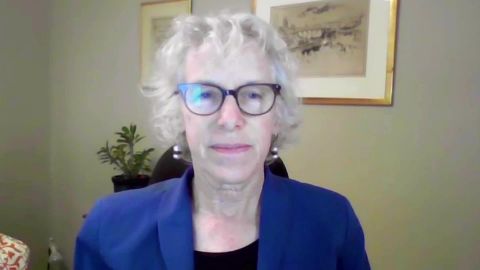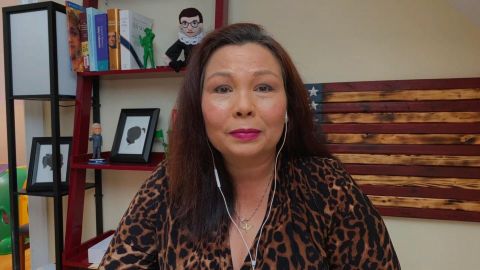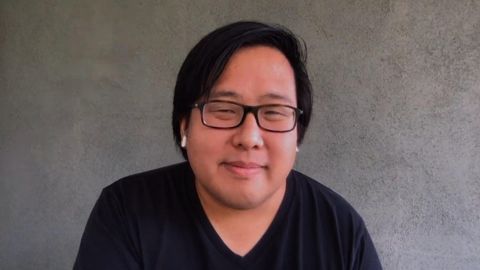Read Transcript EXPAND
CHRISTIANE AMANPOUR: Now, pandemic lockdown forced working parents to find a way to reconcile their jobs with running a household and home schooling. Who is doing the lion’s share? Well, working mothers, says our next guest. Joan C. Williams is the founding director for the Center for WorkLife Law at the University of California. And she tells our Michel Martin about the tough choices working mothers are often forced to make.
(BEGIN VIDEO TAPE)
MICHEL MARTIN: Thanks, Christiane. Professor Joan Williams, thank you so much for talking with us.
JOAN C. WILLIAMS, DIRECTOR, CENTER FOR WORKLIFE LAW: Delighted to be here, Michel.
MARTIN: You spent your career, I mean, really, the last four decades, talking about the barriers to women’s success in the paid work environment. Just give it to me straight. How bad is it right now?
WILLIAMS: Well, it’s a mixed picture, but it’s pretty bad. I feel like we may well be facing a generational wipeout of mothers’ careers. I have spent decades trying to help mothers support their families and care for their families at the same time. And we’ve made a significant amount of progress. But what is happening under COVID is truly, truly, truly sobering. Because mothers have joined the work force by taking advantage of kind of a care infrastructure. We call this our childcare, our kids’ teachers, the aides who take care of our elderly parents. And all of that disappeared overnight. And what’s happened is that mothers have been left trying to do three jobs. Their own job, their childcare worker’s jobs, and their kids’ teachers’ jobs. And very often for that sandwich generation, the job of caring for elderly parents as well, because they don’t want people coming in because elderly people are much more subject to severe cases of COVID, as we now know. And, you know, news flash. If somebody is doing three jobs, they can’t pay the same amount of attention to their job at work.
MARTIN: Let’s dig into some of these things. Let’s take some of these things sort of separately, if we can. First of all, let’s just talk about the job loss. And by women count — women accounted for 55 percent of the 20.5 million jobs lost in April. This is according to the Bureau of Laborstatistics. Why is it that women have disproportionately lost their jobs?
WILLIAMS: I think discrimination is a very important factor. Even mothers, and I think this is such an important point, who are doing everything the way they always did, rising to the occasion at work, even those mothers often find that people want to get rid of them just because they figure, oh, her attention is elsewhere. And so, we see things that — we see a pattern where mothers have taken their three months of leave and then they return, but when they return, the employer clearly is trying to push them out. Hyper scrutinizes what they’re doing. Changes their hours to a schedule the employer knows that the mother can’t work And so, I think that some unscrupulous employers are using this worldwide crisis to force a whole generation of mothers out of the workplace and off the career track.
MARTIN: That’s interesting because we keep seeing these, like, cute videos that go viral of, you know, kids coming in while the parents are trying to sort of do interviews and things like that, and people seem to be responding warmly to it, at least that’s what we see online. But what I think I hear you saying is the reality of it is that a lot of employers are not responding to the current environment. They’re not responding to the fact that parents are having to work at home or caregivers are having to work at home, and it’s actually a more hostile environment than I think a lot of people have been led to believe that it is. Is that true?
WILLIAMS: I think it’s a really bigger picture, Michel. I think – I mean, I have heard from people at one very large American company that now they feel that they can bring their family into their work life in a more open way than they ever were able to do before. And it’s because their manager is talking about their elderly mom, that they’re taken care of, they see the dogs and the kids and everything. So, that is definitely going on. And another thing that’s going on which is really striking is that I have talked to some couples that, one woman in particular that I’m thinking where she said you know before the pandemic – excuse me – before the pandemic, my husband and I split things. I did 80, he did 20. Now she said it’s more 50-50 because he sees what I was doing. And it’s harder not to contribute equally when we’re both in the house. So, there are some bright spots, but we also hear from people whose employers are getting really upset if for some reason you know the dog gets sick in the middle of a Zoom call so it’s a mixed picture. The other part that is kind of a COVID silver lining is that, I mean, I and others have been talking about job shares, remote work, workplace flexibility for 20 years. And we long knew that the only thing that was holding back remote work was a complete failure of imagination. Just like I don’t know – I don’t understand it, I’m not going to go there. That failure of imagination with respect to remote work was solved in three weeks flat where so many jobs went – went remote. And 73 percent of executives say that the remote work has been a success. And I think that’s going to be a really important step going forward, even after COVID, because I think the resistance to remote work is really diminished in many corridors. Now, of course, the people can remote work. There is a certain class structure to all of this, all right?
MARTIN: One of the others I should jump out, there are a number, but one is that you know 14 percent of women say that they’re considering quitting their jobs due to work family conflict related to COVID-19, but so are 11 percent of men. And so, which is something that I think a lot of people might be surprised by. So, do you think it’s a main factor here that people have still have stereotypes about women that are in the paid labor force, or is it the fact of being a caregiver just for some employers they just think, you can’t possibly do the job I need done because you’re taking care of people.
WILLIAMS: I think it’s both. I think that some employers have — just think that a mother is not going to be able to go flat out in the same way that a man can. It’s just pure stereotypes, and we see that time and again. I also think that some other employers feel they have been very flexible for quite a long time, and we all thought this was going to last you know for six weeks or 14 weeks, and then it may last for 18 months. And the employers go like this. I’m up to here. I’ve had it. Moving on. I also think that there are some employers who are really rising to the occasion in an admirable way and opening their eyes with respect to not only telecommuting but also flexible work in a way they never thought they would six months ago. Because, of course, once you’re working from home, workplace flexibility is just a reality. I mean very few people are going to sit you know in their seat eight hours straight if they’re working from home. And so, that’s why I think it’s such a mixed picture. But at the bottom end of the privilege ladder, I think it’s really important to point out that we have heard from these women. Women being ordered back to work, telecommuting ending. And them facing the choice of going to work and leaving their small children home alone or staying home and ending up evicted with unable to feed them. And that has always been a reality in the United States. It is the ugliest face of work family conflict. And if you think about it, that mom really has two choices that put her at risk. If she stays home with no money, ends up homeless on the street and loses her kids to that reason. Or she goes to work and leaves her kids home alone and she loses her kids because someone calls Child Protective Services. That is the most alarming face of work family conflict, and we are hearing from those women on our hotline.
MARTIN: And I presume that black and brown women would be disproportionately affected by that reality, simply because black and brown women tend to be – they don’t have to be frontline workers, they tend – they are just disproportionate share of workers deemed essential. Isn’t that right? You know, grocery store workers, you know people who work in, you know, frontline jobs.
WILLIAMS: Absolutely. The class structure in the United States is racialized, but then yet, Michel, I really – I really hesitate to use that formulation which is used again and again and again —
MARTIN: Because?
WILLIAMS: This was really something that happens because of social class. Now, if you look at social class, black and brown more likely are at the bottom of the social class structure. But there’s also a lot of white people who are in exactly the same situation. And when they hear again and again, oh, black and brown, black and brown. They are like, what about me? So, I think it’s – I think again, it’s complicated. Both are true. It is disproportionately black and brown for people, but we have to remember a lot of white people also are being affected by this, poor white people.
MARTIN: But you wrote something that does affect, this is does affect all Americans. This is something that you wrote about earlier this year. You said, with most of us working from home these days, Americans’ workday has increased by 40 percent, roughly three hours a day, the largest increase in the world. That has to affect most people. Why is that?
WILLIAMS: It’s completely — completely crazy. I mean the research on — first of all, making a workplace safe in the age of COVID takes a lot of extra work. So, it takes a lot of extra work for service personnel, just literally more work. I mean if you’re going to go around putting up plexiglass and cleaning every x number of hours, that’s more work. So, that’s I think, a lot of what’s going on at the bottom of the income pyramid. But at the top, those white-collar workers who are telecommuting, the research on telecommuting for a really long time has found that workers who telecommute work longer hours. They tend to work longer hours because they don’t have that commute and they don’t have that sharp distinction between work and non-work and family. And so, it’s not — but the other thing which is really a lot deeper is that we still, in the 21st century, where we have most American families with children are two-earner families. We still find the ideal worker as someone who starts to work in early adulthood and works full-time, full force, overtime whenever needed for 40 years straight. What does that assume? That assumes you have somebody else bearing and taking care of your children. That makes no sense. And so one of the things that we’ve seen most recently is that some employers, in an attempt to balance it all, have tried to be very kind and understanding to parents and dump the extra work on people without children. Well, of course, the next step is going to be a lot of resentment against parents, right? But that is what happens if you fail — if you are working with a definition of the work force that’s really suited to the work force in 1960 rather than the work force of 2020. In the work force of 2020, workers in the course of their lives are going to have a variety of caregiving responsibilities whether or not they have children, and that has to be part of the picture of good management.
MARTIN: I wonder whether this country has just never come to grips with the notion that people will be both in the paid labor force and be caretakers at the same time, and that that occurs over a huge swath of life, as you put it, whether you have children or not. But the reality of it is that caretaking is something that if you don’t fulfill your role, you go to jail. Whether it’s or you get a visit by Social Services whether it’s caretaking of a child or caretaking of a vulnerable senior. That’s a fact. I just wonder. Is the United States sort of unique in not seeing caretaking as something fundamentally, culturally important, socially important, morally important?
WILLIAMS: I think you’re exactly right. I mean European countries have a very robust care infrastructure because they see that that’s what produces the next generation of citizens. Otherwise we’re the last generation never living. Having children is not a private frolic like hang gliding. Having children is raising the next generation of citizens. It is simply different. And so, but in the United States, very often having a child is like, well, you know, it’s like sort of a hobby. So, I think all of that is true. I think that’s a real blindness in the United States. But I also think in the United States we have a blindness about what is the role of work in a good life. And that affects people without children in the United States, because I mean — I’ve traveled quite a bit in Latin America and in Europe, and they think we’re crazy. They think we you know live to work. They say, we work to live. And so — especially – I mean this is, again, this really differs by class. But one of the weird things about the United States is that it’s the elites that overwork obsessively. And so, I think two things need to happen. Certainly, we need to recognize that parenthood, and taking care of elders is part of reproducing our society. And number two, we have to understand that, you know, we have a slash – we have slash and burn capitalism, is what I call it right now. And one of the ways that we clear-cut the forests is we overwork the workers to the extent that they burn out, that if anybody is given a tiny break, there is this huge resentment. There is a very simple answer to this, which is that studies going back to World War II have shown that actually the most productive worker is somebody who works extremely efficiently six hours a day. And if you’re working 12 hours a day, there is a lot of inefficiency there because that’s just not how human beings were built to work decade after decade.
MARTIN: Professor Joan Williams, thank you so much for talking with us.
WILLIAMS: Always a pleasure, Michel. Great to see you.
About This Episode EXPAND
Military veteran Sen. Tammy Duckworth (D-IL) reacts to President Trump’s reported comments about veterans. Photojournalist Kent Nishimura discusses his work documenting the West Coast wildfires. FRONTLINE correspondent Jelani Cobb reflects on police reform and the struggle for racial justice. Joan C. Williams explains how the pandemic is overburdening working mothers.
LEARN MORE



